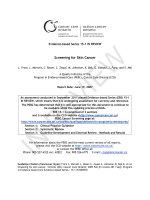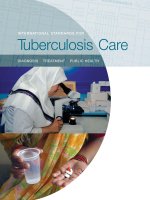Ionizing Radiation Detectors for Medical Imaging doc
Bạn đang xem bản rút gọn của tài liệu. Xem và tải ngay bản đầy đủ của tài liệu tại đây (23.34 MB, 524 trang )
Ionizing Radiation
Detectors
for
Medical Imaging
This page intentionally left blank
1:
World
Scientific
NEW JERSEY
-
LONDON SINGAPORE
-
SHANGHAI
-
HONG KONG
*
TAIPEI
-
CHENNAI
Published by
World Scientific Publishing
Co.
Re. Ltd.
5 Toh Tuck Link, Singapore 596224
USA
ofice:
27 Warren Street, Suite 401-402, Hackensack,
NJ
07601
UK
ofice:
57 Shelton Street, Covent Garden, London WC2H 9HE
British Library Cataloguing-in-Publication Data
A
catalogue record
for
this book is available from the British Library.
IONIZING RADIATION DETECTORS
FOR
MEDICAL IMAGING
Copyright
0
2004 by World Scientific Publishing Co. Re. Ltd.
All
rights reserved. This book, or parts thereoj may not be reproduced in any form or by any means,
electronic or mechanical, including photocopying, recording or any information storage and retrieval
system now known or to be invented, without written permission from the Publisher.
For
photocopying of material in this volume, please pay a copying fee through the Copyright
Clearance Center, Inc., 222 Rosewood Drive, Danvers,
MA
01923,
USA.
In
this case permission to
photocopy is not required
from
the publisher.
ISBN
981-238-674-2
Printed
by Fulsland Offset Printing
(S)
Pte
Ltd,
Singapore
CONTENTS
Foreword
List
of
Contributors
Acknowledgments
Chapter
1.
INTRODUCTION
1.1
Medical Imaging
1.2
Ionizing Radiation Detectors Development: High Energy Physics
1.3
Ionizing Radiation Detectors for Medical Imaging
1.4 Conclusion
versus Medical Physics
Chapter
2.
CONVENTIONAL RADIOLOGY
2.1
Introduction
2.2 Physical Properties of X-Ray Screens
2.2.1
Screen Eficiency
2.2.2
Swank Noise
2.3
Physical Properties of Radiographic
Films
2.3.1
Film Characteristic Curve
2.3.2
Film Contrast
2.3.3
Contrast
vs
Latitude
2.3.4
Film Speed
2.3.5
Reciprocity-Law Failure
2.4 Radiographic Noise
2.5
Definition
of
Image-Quality
2.5.1
MTF
2.5.2
NPS
2.5.3
DQE
2.6
Image Contrast
2.6.1
The Concept
of
Sampling Aperture
2.6.2
Noise Contrast
2.6.3
Contrast-Detail Analysis
9
9
11
14
15
17
17
17
20
23
25
26
27
29
29
30
31
32
34
35
38
40
40
41
42
V
1
3
8
3
2.7
Image-Quality of Screen-Film Combinations
2.7.1
MTF, NPS and DQE Measurement
2.7.2
Quality Indices
References
Chapter
3.
DETECTORS FOR DIGITAL RADIOGRAPHY
3.1
Introduction
3.2
Characteristics of X-Ray Imaging Systems
3.2.1
Figure
of
Merit for Image Quality: Detective Quantum
3.2.2
Integrating
vs
Photon Counting Systems
Eficiency
3.3
Semiconductor materials for X-Ray Digital Detectors
3.4
X-Ray Imaging Technologies
3.4.1
Photo-Stimulable Storage Phosphor Imaging Plate
3.4.2
Scintillators/Phosphor
+
Semiconductor Material
3.4.3
Semiconductor Material (e.g. a-Se)
+
Readout Matrix Array
3.4.4
Scintillation Material (e.g. Csl)
+
CCD
3.4.5
20 microstrip Array
on
Semiconductor Crystal
+
Integrated
3.4.6
Matrix Array
of
Pixels
on
Crystals
+
VLSI Integrated
3.4.7
X-Ray-to-Light Converter Plates (AlGaAs)
(e.g. a-Si:H)
+
TFT Flat Panels
of
Thin Film Transistors (TFT)
Front-End and Readout
Front-End and Readout
3.5
Conclusions
Acknowledgments
References
Chapter
4.
DETECTORS FOR CT SCANNERS
4.1
Introduction
4.2
Basic Principle of CT Measurement and Standard Scanner
Configuration
4.3
Mechanical Design
4.4
X-Ray Components
4.5
Collimators and Filtration
4.6
Detector Systems
44
45
47
48
53
53
58
58
61
64
69
70
78
90
93
96
100
112
115
117
117
125
125
126
128
131
133
137
vi
4.7
Concepts for Multi-Row Detectors
4.8
Outlook
Acknowledgment
References
Chapter
5.
SPECIAL APPLICATIONS IN RADIOLOGY
5.1
Introduction
5.2
Special Applications
5.2.1.
Mammography
5.2.2
Digital Mammography with Synchrotron Radiation
5.2.3.
Subtraction Techniques at the k-Edge
of
Contrast Agents
5.2.3.1.
Detectors and Detector Requirements for
Dichromography
5.2.4.
Phase Effects
5.3
Conclusion and Outlook
Acknowledgment
Appendix
5.2.4.1.
Detectors for Phase Imaging
A. Image formation and Detector Characterization
B.
Digital Subtraction Technique
References
Chapter
6.
AUTORADIOGRAPHY
6.1
Autoradiographic Methods
6.1.1
Traditional Autoradiography: Methods
6.1.2
Traditional Autoradiography: Limits
6.1.3
New Detectors for Autoradiography
6.2.1
Principles
6.2.2
Commercial Systems and Pe$ormance
6.3.1
Principles
6.3.2
Research Fields
6.3.3
Commercial Systems
6.4.1
Principles
6.2
Imaging Plates
6.3
Gaseous Detectors
6.4
Semiconductor Detectors
143
145
147
147
149
149
150
150
155
158
166
169
175
178
179
179
187
189
193
193
195
197
198
198
198
199
203
203
203
206
209
209
Vii
6.4.2
Silicon Strip Detectors
6.4.2.1
Strip Architecture
6.4.2.2
Research Fields
6.4.2.3
Commercial Systems
6.4.3.1
Pixel Architecture
6.4.3.2
Research Systems
6.4.3
Pixel Detectors
6.5
Amorphous Materials
6.5.1
Principles
6.5.2
Research and Commercial Systems
6.6
CCD Based
Systems
6.6.1
Principles
6.6.2
System Description and Pegormance
6.7.1
Principles
6.7.2
System Description and Performance
6.8 Microchannel Plates
6.8.1
Principles
6.8.2
System Description and Pegormance
6.7 Avalanche Photodiodes
References
Chapter
7.
SPECT AND PLANAR IMAGING IN NUCLEAR
MEDICINE
7.1 Introduction
7.2 Collimators
7.2.1
Multi-Hole Theory
7.2.2
Single-Hole Theory
7.2.3
Penetration Effects
7.3.1
Scintillators
7.3 Detectors
7.3.1.1
Ya103:
Ce
7.3.1.2
Gd2SiOs:Ce
7.3.1.3
Lu2SiOs:Ce
7.3.2.1
Materials
7.3.2.2
Nuclear Medicine Applications
7.3.2
Semiconductors
210
210
210
212
214
214
215
219
219
220
22
1
22
1
222
224
224
225
225
225
226
23
1
235
235
237
240
248
248
252
253
254
256
256
258
262
263
Vlll
1.4 Reconstruction Algorithms
1.4.1 Inverse Problems
1.4.2 Ill-Posed Problems
1.4.3 Ill-Conditioning and Regularization
1.4.4 The Radon Transfom
1.4.5 Analytical Methods: Filtered Back-Projection
7.4.6 Iterative Algorithms
1.5.1
High-Resolution SPECT Imaging
I
S.2 Planar Imaging from Semiconductor Detectors
1.5.3 Attenuation Corrected Imaging
7.5 Clinical Imaging
References
264
265
265
266
268
269
212
218
219
219
280
283
Chapter
8.
POSITRON EMISSION TOMOGRAPHY
281
281
8.1.1
Tomography Procedures and Terminologies
289
292
8.2.1
Positron Emission and Radionuclides 292
8.2.2
Annihilation
of
Positron 296
8.2.3
Interaction
of
Gamma Rays
in
Biological Tissue 302
303
8.3.1
Photon Detection with Inorganic Scintillator Crystals 304
8.3.2
Inorganic Scintillator Readout 311
8.3.3
Parallax Error, Radial Distortion and Depth
of
Interaction 316
8.4.1
The Filtered Backprojection 320
8.4.2
The Expectation Maximisation Algorithm
330
8.4.3 The OSEM Algorithm 336
8.5
Correction and Normalization Procedures 331
8.5.1
Attenuation 337
8.5.2
Scattering 34 1
8.5.3
Random Coincidences 348
8.5.4 Partial Volume Effect 350
8.5.5
Normalization 35 1
8.6
Commercial Camera Overview 353
References 355
8.1
Introduction to Emission Imaging
8.2 Physics
of
Positron Emission Tomography
8.3 Detection
of
Annihilation Photon
8.4 Image Reconstruction 318
ix
Chapter
9.
NUCLEAR MEDICINE: SPECIAL APPLICATIONS
IN FUNCTIONAL IMAGING
9.1
Introduction
9.2
Position Sensitive Photo Multiplier Tube
9.2.1
Hamamatsu First PSPMT Generation
9.2.2
Hamamatsu Second PSPMT Generation
9.2.3
Hamamatsu 3rd Generation PSPMT
9.3
Signal Read Out Methods and Scintillation Crystals
9.4
The Role of Compact Imagers in Clinical Application
References
Chapter
10.
SMALL ANIMAL SCANNERS
10.1
Introduction
10.2
Position Sensitive Detectors
10.2.1
Gamma-Ray Detection
10.2.2
Scintillator Based Position Sensitive Detectors
10.2.2.1
Continuous Scintillators
10.2.2.2
Matrix Crystals
10.3
Single Photon Emission Computerized Tomography (SPECT)
10.3.1
The Detector
10.3.1.1
Intrinsic Spatial Resolution
in
SPECT
10.3.1.2
Energy Resolution
10.3.1.3.
Rate
of
Acquisition and Detector Speed
10.3.2.1
Pinhole Collimator
10.3.2.2
Parallel Hole Collimator
10.3.3
Small Animal SPECT Scanners Examples
10.3.2
Collimator Geometries
10.3.3.1
Pinhole Collimator Scanners
10.3.3.2
Parallel Hole Collimator Scanners
10.3.3.3
Converging Hole Collimator Scanner
10.4
Positron Emission Tomography (PET)
10.4.1
Physical Limitations to Spatial Resolution
10.4.1.1
Electron Fermi Motion
10.4.1.2
Scattering in the Source
10.4.1.3
Positron Range
359
359
36
1
361
363
364
3 66
372
380
385
385
386
386
393
394
395
3 97
399
3 99
400
402
402
402
405
406
406
408
412
415
415
416
418
419
X
10.4.2
ESficiency and Coincidence Detection
of
511
keV
gamma rays
10.4.2.1
Intrinsic Detector ESficiency
10.4.2.2
Detector Scatter Fraction
10.4.2.3
Intrinsic Spatial Resolution
10.4.2.3.1
Detector intrinsic spatial resolution
10.4.2.3.2
System intrinsic spatial resolution
10.4.2.4
Random Coincidences and Pile
Up
Events
10.4.2.5
Energy Resolution
10.4.3
Small Animal PET Scanner Geometries
10.4.3.1
Planar Geometry
10.4.3.2
Ring Geometry
10.5
Small Animal PET Scanner Examples
10.5.1
First Generation Animal Scanners
10.5.1.1
Hamamatsu SHR-2000 and SHR-7700 Scanners
10.5.1.2
CTI-PET Systems ECAT-713
10.5.2.1
Hammersmith RatPET
10.5.2.2
MicroPET
10.5.2.3
Sherbrooke PET and the Munich MADPET
10.5.2.4
The NIH Atlas Scanner
10.5.2.5
Scanner
of
the Brussels Group: The VUB-PET
10.5.3
Dedicated Rodent Rotating Planar Scanners
10.5.3.1
YAP-(S)PET and TierPET
10.5.3.2
HIDAC
10.5.2
Dedicated Rodent Ring Scanners
10.6
Conclusions
References
Chapter
11.
DETECTORS
FOR
RADIOTHERAPY
1 1.1
Introduction
11.2
Introduction to Radiotherapy
1 1.2.1
External Beam Radiation Delivery
11.2.2
Requirements for Standards and Reporting
11.3
The Physics
of
Detection
for
Radiotherapy
1
1.3.1
Photon Interaction Mechanisms
1 1.3.2
Electron Interaction Mechanisms
422
422
423
426
426
427
428
430
43 1
43 1
433
435
435
435
436
437
437
440
445
447
448
450
450
456
460
46
1
465
465
466
466
468
469
469
47
1
Xi
11.3.3
Units
11.3.4
Charged Particle Equilibrium and Cavity Theory
11.3.5
Effects
of
Measurement Depth
11.3.6
Quality Assurance and Verijkation Measurements
1 1.4.1
Ionisation Chambers
1 1.4.2
Themzoluminiscent Detectors
1 1.4.3
Diode Detectors
1 1.4.4
Diamond Detectors
11.4
Point Detectors
11.5
Film
1 1.6
Electronic Portal Imaging
11.6.1
Camera-Based Systems
11.6.2
Liquid Ionisation Chamber Based Systems
11.6.3
Amorphous Silicon Flat-Panel Systems
1 1.7.1
Fricke Dosimetry
11.7.2
Polymer Gels
11.7
Radio-Sensitive Chemical Detectors
References
473
474
47
5
476
478
478
482
484
487
489
492
494
495
496
497
497
498
499
Analytical
Index
xii
501
To
Marta,
Simone
and
Nicoli,
This page intentionally left blank
FOREWORD
The idea of this book originates from a series of lectures on “Detectors
Application in Medicine and Biology” that I was asked to give as part of
the Academic Training Program at CERN in
1995.
In
preparing the
series of lectures, I realized that I would be talking about detector
properties and the medical applications of these detectors to the scientists
and engineers who were their inventors. Initially, this realization scared
me but, soon after the lectures were delivered, it convinced me about the
necessity of writing a book dedicated to detectors for medical imaging,
where the properties of the detectors were to be discussed specifically in
relation to each medical or clinical applications.
This book is the outcome of this conviction. It took quite a while to
become a reality due to the many sub-specialities in Medical Imaging I
wanted to be addressed. Intentionally, this book‘s coverage is limited to
Ionizing Radiation Detectors; thus Ultrasound, Magnetic Resonance
Imaging and Spectroscopy and other non-Ionizing Radiation Detectors
have not been considered.
The book comprises a brief “Introduction” and ten technical
chapters, almost
50%
of which are dedicated to Radiology and
50%
to
Nuclear Medicine. The last chapter describes the detectors for
Radiotherapy and Portal Imaging. Each chapter completely addresses a
specific application. Hence, some properties of one class of detectors
may be described or discussed in more than one chapter but I consider
this to be a plus. The emphasis is always on detectors and detector
properties. When necessary, software and specific applications are
described in depth.
The book is intended for students in physics and engineers who want
to study Medical Imaging, both at undergraduate and post-graduate level.
Scientists, who are working in a specific sub-field of medical imaging,
could use this book to acquire an up-to-date description of the state-of-
the-art in other related sub-fields, alas within the scope of ionizing
1
A.
Del Guerra
radiation detectors. Other Scientists and Physicians could use this book
as a reference for Medical Imaging.
Many thanks are due to the various contributors who agreed to write
the many chapters, and have been patient with me whilst the book was
completed. A special acknowledgement is due to Dr. Deborah Herbert
for her careful reading of some chapters.
Pisa, January
3
1,2004
Albert0 Del Guerra
2
LIST
OF
CONTRIBUTORS
Albert0 Del Guerra
obtained his degree in Physics at the University of Pisa (Italy) in 1968.
He was Visiting Professor and Fulbright Scholar at the Lawrence
Berkeley Laboratory, University of California, USA in 1981-82 and
became Associate Professor of Physics at the University of Pisa, Italy in
1982. He was then Full Professor of Physics at the University of Napoli
“Federico 11”, Italy (1987-1991), Full Professor of Medical Physics at the
University of Ferrara, Italy (1991-1998) and since 1998 he has been Full
Professor of Medical Physics at the University of Pisa, Italy. He is
Director and Head of the Specialty School in Medical Physics,
University of Pisa, Italy. His research activities in the last
25
years have
been in the field of Medical Physics, and particularly in medical imaging
for radiology and nuclear medicine. PET scanners for functional imaging
with small animals has also been a particular focus. He is Editor in Chief
of the journal “Physica Medica-European Journal of Medical Physics”
and President of the European Federation of Organizations of Medical
Physics (EFOMP).
Mariu Evelina Fantacci
obtained her degree in Physics in 1992 at the University of Pisa (Italy),
where she has held the position of Physics Researcher at the Physics
Department since 1997. She has always worked in the field of medical
physics. Her present research activities focus on digital mammography.
In particular: the use of semiconductor pixel detectors connected via
bump-bonding to single photon counting electronics and the
development
of
Computer Aided Detection tool for automated
classification of textures and search of micro-calcification clusters and
massive lesions.
3
List
of
Contributors
Andreas Formiconi
holds the position of Physics Researcher at the University of Florence.
His research focuses on Single Photon Emission Tomography and on the
development of physical and mathematical methods for the solution of
inverse problems in the bio-medical field.
Theobald
O.J.
Fuchs
received his diploma in physics from the University Erlangen Nurnberg,
Germany, in 1994. His diploma thesis was partly completed at the
European Laboratory for Particle Physics (CERN) in the field of
experimental particle physics. He did
his
Ph.D. research with Willi
Kalender at the Institute of Medical Physics
(IMP),
Erlangen, Germany.
Since 1999, he has been working as a fellow researcher at the
IMP.
His
present research activities focus on image quality analysis in
CT,
artefact
corrections, X-ray detectors, and dose optimization.
Willi A. Kalender
received his Masters Degree and Ph.D. in Medical Physics from the
University of Wisconsin, Madison, Wisconsin, USA in 1979.
In
1988 he
completed all postdoctoral lecturing qualifications (Habilitation) for
Medical Physics at the University of Tubingen. From 1979 to 1995 he
worked in the research laboratories of Siemens Medical Systems in
Erlangen. Since 1991 he has been an adjunct Associate Professor of
Medical Physics at the University of Wisconsin; from 1993 to 1995 he
lectured at the Technical University of Munich. In 1995 he was
appointed a full professor and the director of the newly established
Institute of Medical Physics at the University Erlangen Nurnberg,
Germany. His main research interests lie in the area of diagnostic
imaging. The introduction and further development of volumetric spiral
CT has been a particular focus. Other fields of research are radiation
protection and the development of quantitative diagnostic procedures,
e.g. for the assessment of osteoporosis, lung and cardiac diseases.
4
List
of
Contributors
Ralf Hendrik Menk
obtained the Diplom Physiker at the University
of
Siegen, Germany, in
1990. He was a Ph.D. student at the University of Siegen, and concluded
with the degree “Dr.rer.nat” in 1995. He has been a postdoctoral fellow
at the medical beam line at HASYLAB at DESY, Hamburg and a
postdoctoral fellow at the medical beam line at the National Synchrotron
Light Source at Brookhaven National Lab., Upton, New York, USA, and
an Assistant Professor at the University of Siegen, Germany. Since 1999
he has been the head
of
the Instrumentation and Detector Group at the
Sincrotrone Trieste, Italy. His research interest is in the development of
instrumentation for synchrotron radiation experiments.
Alfonso
Motta
obtained his degree in Physics in 1997 and his PhD in
2000
at the
University
of
Ferrara (Italy). He is working on 3-D algorithms and image
reconstruction in Medical Imaging. He now holds a postdoctoral
appointment at the Department of Physics
“E.Ferrni”
,
University of Pisa
(Italy).
Roberto Pani
obtained his degree in Physics at the University
of
Roma “La Sapienza”,
Italy. He has been appointed an adjunct Associate Professor at the
Department
of
Radiology of Georgetown University in Washington,
USA.
He holds the position
of
Associate Professor in Medical Physics at
the University of Rome “La Sapienza”. He has been working for more
than twenty years in the field of advanced detectors for X-ray and
gamma-ray spectrometry using scintillators and semiconductors. Since
1990 he has been working on single photon imaging detectors for
Nuclear Medicine, with particular emphasis on small animal imaging and
scintimammography (SPEM).
5
List
of
Contributors
Mike Partridge
gained his PhD in 1995 in applied optics and image processing at
Cranfield University, UK. He joined The Institute of Cancer Research
(Sutton, UK) as a postdoctoral researcher in 1996 and worked as part
of
a
team developing the use of electronic portal imaging for radiotherapy
verification. From
2000
until
2002
he worked at the German Cancer
Research Centre (DKFZ) in Heidelberg.
In
2002
he moved back to the
UK and took up a joint position with the Institute of Cancer Research
and the Royal Marsden NHS Trust, focusing on the clinical
implementation of advanced radiotherapy techniques and research into
the use of functional imaging for radiotherapy target definition.
Alessandro
Passeri
obtained his degree in Physics in 1985 at the University of Florence,
Italy. He initially worked in theoretical nuclear physics before moving to
the field of Medical Imaging, where he obtained his PhD in 1990. He
holds the position of Physics Researcher at the University of Florence.
Since 1996 he has been the director of the research centre on Magnetic
Resonance Imaging at the University of Florence. His research focuses
on Single Photon Emission Tomography and on the development of
physical and mathematical methods for the solution
of
inverse problems
in the bio-medical field.
Paolo
Russo
graduated in Physics at the University of Napoli in 1981. He became a
Physics Researcher in 1984, an Associate Professor in 1992 and a Full
Professor of Medical Physics in 2002 at the Department
of
Physical
Sciences of the University
of
Napoli “Federico
II”,
Italy. His research
activity has always been in the field of Medical Physics. His scientific
interests now focus on the development of semiconductor radiation
detectors for medical imaging, for digital radiography and
autoradiography. He has been developing silicon microstrip detectors
6
List
of
Contributors
and silicon or GaAs pixel detectors for single photon counting X-ray and
beta-ray imaging applications.
Angelo Taibi
obtained his degree in Physics at the University of Ferrara and his PhD in
Medical Physics at the same University in 1997.
In
1998 he was awarded
a Marie Curie Fellowship, to engage his research as a post-doc at the
Department of Medical Physics and Bioengineering, University College
London, UK. He now holds a post-doc position at the Department of
Physics at the University of Ferrara. His research interests concern the
physics of X-ray imaging and in particular: optimization of
mammography examination, dose reduction by means of quasi-
monochromatic X-rays and diffraction enhanced breast imaging.
Guido
Zavattini
obtained
his
degree in physics at the University of Pisa, Italy, working on
an experiment to verify the Equivalence Principle with optical
techniques, and his PhD in Physics at the University of Bologna, Italy on
the development
of
a fast neutron detector with double pulse shape
discrimination.
A
one-year post-doc fellowship, working for
INFN,
Trieste, Italy, brought him back to working on optics in a collaboration to
measure
the
magnetic birefringence of vacuum. He now holds the
position of Physics Researcher at the University of Ferrara, Italy.
In
2002-2003
he spent a sabbatical year at the University of Davis,
California, USA. His research interest focuses on position sensitive
gamma ray detectors for small animal PET and SPECT imaging.
7
ACKNOWLEDGMENTS
0
We would like to explicitly acknowledge the
following
Publishers,
Companies and Authors for the granted permission for the reproduction
of
the following figures and table in this book:
the Hamamatsu Photonics
K.K.,
for Figs.
2.4, 9.6, 10.4;
the Philips’ Gloeilampenfabrieken, for Fig.
2.6;
the International Commission on Radiation Units and
Measurements, for Figs.
2.13, 2.14;
the IEEE Nuclear and Plasma Sciences Society, for Figs.
2.16,
3.21, 3.22, 3.24, 3.27, 3.48, 3.49, 3.50b, 3.51, 3.52, 3.53, 3.54,
7.4, 7.5, 7.6, 10.14, 10.15, 10.16, 10.35, 10.50, 10.53, 10.54,
10.55, 10.58, 10.62, 10.63, 10.64;
the Radiological Society of
North
America, for Fig.
2.20;
the Elsevier Science, for Figs.
3.4, 3.6, 3.8, 3.16, 3.17, 3.30,
3.31, 3.34, 3.39, 3.40, 7.8, 7.9, 8.17, 8.18, 9.1, 9.2, 9.3, 9.5, 9.8,
9.9, 9.10, 9.11,
9.13,9.14,9.15,Table9.1;
the American Institute of Physics, for Figs.
3.9, 3.15;
the Nuclear Technology Publishing, for Fig.
3.18;
the IOP, for Figs.
3.35, 3.41;
the Publicis KommunikationsAgentur GmbH, for Figs
4.1, 4.2,
4.3,4.4,4.5,
4.6,4.7,4.8,4.9,4.10,4.11;
Dr. Bill Ashburn, for Fig.
7.8;
the American Society of Nuclear Cardiology, for Fig.
7.10;
the University
of
Chicago Press, for Fig.
8.5;
the Nuovo Cimento, for Fig.
8.9;
the Istituti Editoriali e Poligrafici Internazionali, for Fig.
9.16;
the Springer-Verlag, for Figs.
10.40, 10.49, 10.61;
the World Scientific Ltd,
for
Fig.
11.9.
8
CHAPTER
1
INTRODUCTION
Albert0
Del
Guerra
Department
of
Physics, University
of
Pisa
and
INFN,
Sezione di
Pisa,
Pisa, Italy
(e-mail:
)
1.1
Medical Imaging
The enormous development in detectors for Medical Imaging has been
largely due to contributions from the technological innovations in other
fields of physics, such as solid state physics, space physics and high
energy Physics
(HEP).
In particular the latter has greatly contributed
greatly to the development of new types of detectors, particularly for
ionizing radiation. However, it is extremely important to recall that a
detector for medical applications is a
“special
detector”,
the performance
specifications being related to patient comfort, diagnosis and eventual
therapy. In this respect, some specific concerns will be presented in the
next session.
Table 1.1 lists the major fields in medical diagnosis together with the
parameters measured and the specific medical applications. The progress
in
the
last twenty years has only been possible with the advent of
integrated electronics and fast computers. This has permitted the shift
from analog to digital imaging, with more quantitative information being
available for diagnosis and prognosis.
X-ray radiology is of course the primary field: radiology has moved
from 2-D to 3-D (with the advent of the CT-scanners) and to Digital
techniques. It was more than a hundred years ago that the first radiograph
was taken by William Roentgen and since then film has been used as
“the
detector”
for radiological examination. Only CT-scanners have
9









